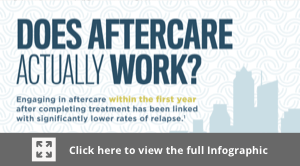Addiction Aftercare Programs for Substance Abuse Rehab
 Addiction is a complex, demanding, and frustrating condition, but effective treatment can help to improve the lives of people who struggle with it. When treatment options are extensively available and tailored to the needs of the individual, better results are possible.
Addiction is a complex, demanding, and frustrating condition, but effective treatment can help to improve the lives of people who struggle with it. When treatment options are extensively available and tailored to the needs of the individual, better results are possible.
Sadly, the vast majority of people who need specialized substance abuse treatment do not receive it. According to a report by the Substance Abuse and Mental Health Services Administration (SAMHSA), only about 11% of people who needed treatment for substance abuse received it.
If you are one of the 2.5 million people that have already sought out treatment or successfully completed your initial level of care in the last year, congratulations. Taking the first step towards treatment for an addiction to alcohol or other drugs is a monumental step that many people never take. But there is more work to do.
Addiction treatment is not a process that ends after detoxification (detox) or an initial rehabilitation (rehab) program. Taking measures to live a drug-free lifestyle is a long-term commitment. This process can include a wide variety of treatment options and supports. As part of the continuum of treatment, an aftercare rehab program for addiction is an important part of overall recovery.
What Is Aftercare for Substance Abuse Treatment?
“Aftercare” is a general term used to describe any ongoing or follow-up treatment for substance abuse that occurs after an initial rehab program. No matter the setting, treatment provider, or methods used, the goals of addiction aftercare programs are the same and include:
- To maintain recovery from substance abuse.
- To find ways to prevent relapse.
- To achieve a life filled with rewarding relationships and a sense of purpose.
Many individuals first embark upon their substance abuse treatment journey with a period of detoxification. Depending on the substances abused and the recommendations of a treatment professional, this first-line measure may require medically-assisted detox.
Although detox is an effective first step, alone it is rarely adequate for long-term abstinence from alcohol and other drugs. Upon successful completion of detox, many recovering individuals continue on with a period of structured addiction treatment—either in an inpatient/residential or outpatient setting.
Although the timeline for rehab or any formal treatment duration will vary, at some point this phase of recovery will approach an endpoint. Ongoing recovery efforts, however, are likely and encouraged to continue. This is where diligent aftercare planning becomes important. Substance abuse treatment programs that make lasting recovery a priority will not send program participants on their way without a solid discharge plan and connecting them with quality aftercare programs.
Types of Addiction Aftercare
There are many types of addiction aftercare programs. These programs cover a range of options that vary based on the intensity, setting, staffing, and duration of treatment. The appropriate type of aftercare will depend greatly on your individual symptoms, needs, and status following the completion of an initial rehab program.
Sober Residences
 For people who started treatment with inpatient services, some form of sober residence could be an appropriate aftercare option. Sober residences may be most appropriate for people with risky home living situations or those who lack strong support outside of treatment. Sober-living arrangements as aftercare options include:
For people who started treatment with inpatient services, some form of sober residence could be an appropriate aftercare option. Sober residences may be most appropriate for people with risky home living situations or those who lack strong support outside of treatment. Sober-living arrangements as aftercare options include:
- Therapeutic communities: Highly structured programs that can last for 6 to 12 months. Staff and residents work together to obtain and maintain recovery. Treatment will help the individual change negative beliefs and destructive patterns. Educational, vocational, and other supports will be offered.
- Recovery housing: Offers short-term, supervised housing for people in recovery. These will offer less intense services that are focused on connecting individuals to outside resources as they transition towards independence.
- Social model: Often simply referred to as sober living, the social model offers no formal, professional treatment or staff in the home. Instead, the individuals within the home rely on each other for support and guidance. Sober-living houses often require that residents work to pay bills and attend outside treatment.
- Residential re-entry centers: Often called halfway houses, these centers are reserved for people in recovery that are also involved in the criminal justice system. These will share similarities to sober-living houses, but with more structure and accountability.
Outpatient Aftercare Therapy
Any aftercare program that allows the client to attend treatment during the day and return home at night is called outpatient treatment. This option may be best for people who work, have childcare responsibilities, or have personal support that makes recovery possible without the intensity of residential treatment. Outpatient aftercare increases or decreases in intensity as needs change. Options include:
- Partial hospitalization programs (PHP): The most intense outpatient treatment that includes services 5 days a week for 4-6 hours a day. This will include individual and group therapy.
- Intensive outpatient programs (IOP): With appointments two or more times per week that last for 3 hours, IOP can focus on addiction and mental health care.
- Individual and/or group addiction therapy: Regularly-scheduled hour-long sessions that occur weekly, biweekly, or monthly.
Support Groups
 Support groups and social networking give people who are overcoming addictions the ongoing encouragement and support needed to help them continue to recover and stay sober long term. These groups include other people who are going through or have gone through the same type of experiences, so they can help each other. These options for aftercare include:
Support groups and social networking give people who are overcoming addictions the ongoing encouragement and support needed to help them continue to recover and stay sober long term. These groups include other people who are going through or have gone through the same type of experiences, so they can help each other. These options for aftercare include:
- 12-step groups: Build fellowship and a drug-free social network, placing emphasis on a higher power to achieve and maintain sobriety. Common 12-step groups include Alcoholics Anonymous, Narcotics Anonymous, Women in Sobriety, SMART Recovery, and more.
- Non-12-step groups: For people recovering from addiction who prefer a secular (non-religious or non-spiritual) approach to aftercare.
- Peer recovery support network: Offering case management and peer support services provided by someone in recovery to encourage ongoing recovery goals.
- Adolescent programs: Provide specialized support focused on social skills and self-esteem issues often related to teens and young adults staying sober.
Some people continue to attend aftercare groups like these to offer support to others who are just starting their path to recovery. Others choose to attend meetings for continued recovery reinforcement and to remain connected to the important supportive community they have become a part of.
Alumni Programs
Transitioning back into society after rehab can be different, but alumni programs can help. Alumni programs are designed to help people in recovery from substance abuse maintain their sobriety after they complete a treatment program. While alumni programs differ, many offer various resources such as educational materials, employment assistance, and direct contact information for counselors, therapists, and other relevant medical professionals. One of the biggest benefits of an alumni program is that it allows you to connect with others people in recovery from your treatment program. Many alumni programs put on social events and encourage alumni members to keep in touch for ongoing support.
Why Is Addiction Aftercare Important?
One reason that continuing treatment is essential in all situations is that longstanding substance abuse can, in some cases, alter the normal functioning of the brain. Some of these changes do not instantly reverse once use ends. In fact, they can last long after substance use has terminated.
The physical impact of addiction is often accompanied by several psychological changes—affecting thoughts, feelings, and behaviors that may persist even after the substance is removed from the body. The physiological changes associated with addiction and their potential lasting impact on both mental and physical health reaffirms the need for long-term treatment.
Although addiction treatment can be effective, relapse is common due to the nature of addiction. Even after treatment, it can be hard for a person to cope with the stressors of everyday life in a healthy way. Participating in an addiction aftercare program can help reinforce the skills you learned in recovery which can help you maintain sobriety.
Those who have struggled with addiction know that it can be isolating and lonely, especially after your treatment program ends. Aftercare can provide the foundation to create or build upon a healthy and supportive network of people who can help you maintain positive changes and habits.
Components of Successful Aftercare
SAMHSA has outlined treatment characteristics that contribute to recovery in successful aftercare programs. The four components of successful aftercare are:
- Health: Health-related services will provide the individual in treatment with measures to overcome or reduce their target symptoms. This is accomplished through a number of steps including:
- Assessment for substance use and mental health problems.
- Testing for alcohol and other drugs as well as infectious disease.
- Medication services for addiction or mental health.
- Education related to medical, mental health, or substance abuse.
- Home: Home services focus on ensuring that the person in treatment has stable and supportive housing during and following the program. Quality aftercare programs will offer support in finding housing, connecting to available services, and transporting to appointments.
- Purpose: Building a stronger sense of purpose is associated with improved recovery. By helping the individual find meaning through work, school, or family responsibilities, the person in recovery will gain motivation to remain drug-free.
- Community: The community aspect of aftercare entails the sense of love, belonging, and hope that comes from strong relationships. Aftercare programs can create programs to help the person:
- Build new social networks.
- Improve current relationships.
- Engage in healthy relationships.
- Find community involvement.
Even if the principles of an aftercare treatment program are strong, there are ways for it to be ineffective. One way to create poor treatment is through poor staffing. Strong staffing at an aftercare program should:
- Use a team approach between other staff and clients.
- Be multidisciplinary with experts in a wide range of services.
- Work closely with outside support systems.
- Be consistent with low turnover.
If an aftercare program does not reflect these values by offering limited services with frequently changing staff, it might not be the best fit for treatment.
Is Aftercare Effective?
Like many serious chronic conditions, there is no easy cure for addiction. Relapse is always a possibility, which makes it challenging to measure the effectiveness of an aftercare program. Effective treatment reduces symptoms, and poor or absent treatment is linked to increased frequency of symptoms or occurrences such as relapse. This is true of addiction as well as other chronic physical health conditions such as:
- Type 1 diabetes.
- Hypertension.
- Asthma.
Even with treatment, relapse occurs in between 40-60% of people. Relapse is more common in people with fewer supports and more severe additions. It is important to note that relapse does not mean that the previous treatment was unsuccessful. It only indicates that the individual would benefit from restarted, modified, or alternative aftercare options.
A contributor to greater success measured by fewer relapses and longer periods of abstinence is the length of treatment. The National Institute on Drug Abuse (NIDA) reports that most people require at least 90 days of treatment to end their drug use. Longer treatment periods are correlated to better results, which suggests that the duration of treatment may be more important than the type of treatment.
Finding Effective Addiction Aftercare
 There will be a tremendous variation among addiction aftercare programs, but effective treatments will share a common philosophy that the best treatments account for the entire person and all their needs. Based on this treatment principle, the best aftercare programs will offer comprehensive services that address the individual’s:
There will be a tremendous variation among addiction aftercare programs, but effective treatments will share a common philosophy that the best treatments account for the entire person and all their needs. Based on this treatment principle, the best aftercare programs will offer comprehensive services that address the individual’s:
- Relationships.
- Child care.
- Housing and transportation.
- Finances.
- Legal involvement.
- Vocation.
- Education.
- Medical status including HIV/AIDS testing and treatment.
- Mental health.
This system is based on the understanding that imbalance with any of these components could lead to increased stress and a greater chance of relapse. If aftercare only focuses on one area, it may not be addressing the root of the greater issue.
For example, SAMHSA reports that roughly 7.7 million adults struggle with a co-occurring substance use disorder (also called dual diagnosis) and some form of mental illness. By only treating one condition, there is an opportunity for the co-occurring issue to worsen, which may lead to relapse or other unwanted consequences in the future.The best addiction aftercare will take a comprehensive approach to your treatment and be tailored to your individual needs. If you need help finding care, contact our admission navigators today.
